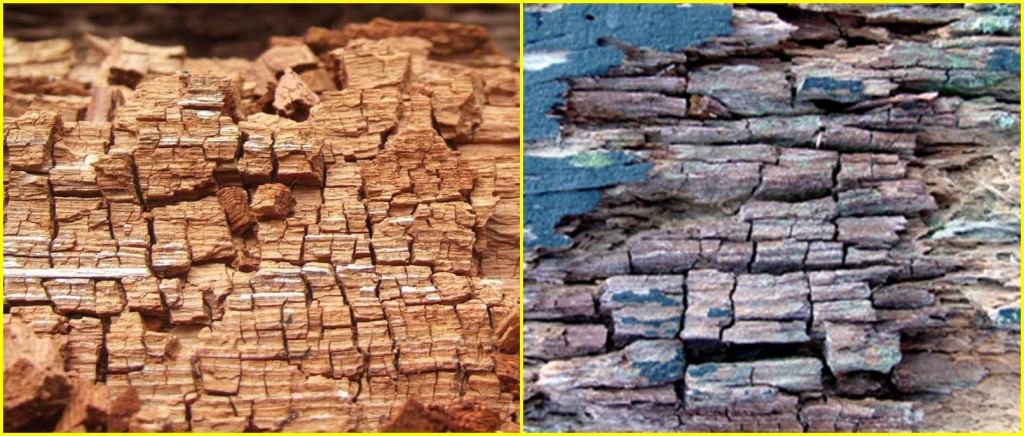 Yes, you read that right: dry rot is responsible for about $17 BILLION in property damage each year throughout the United States. And Osceola County properties are as susceptible as any others in the US.
Yes, you read that right: dry rot is responsible for about $17 BILLION in property damage each year throughout the United States. And Osceola County properties are as susceptible as any others in the US.
Although dry rot is not the most common type of rot in Osceola County, it can deal serious damage to your home and endure conditions that are too dry for other types of wood rot to thrive.
Dry rot is so insidious, that 75% of wood’s toughness is possible with only a 1% decrease in the weight of the wood and destroys about 20 billion board feet of timber the United States each year; far more than is destroyed by fire.
“Dry rot” is a term that describes a particular kind of dry, cracking, rotting wood. Dry rot originally got its name because of the wide belief that this type of rot didn’t need water and used a fermentation process to survive. Research has proven this untrue and – while the old name hangs on – dry rot occurs because of a variety of brown rot called Serpula lacrymans.
Yet, the damage it does is no less severe and property owners should keep a keen eye for it. Dry rot fungus spores are present in most homes and can survive for several years, waiting for the right conditions to grow. Wood damaged by dry rot creates small, rectangular pieces of crumbling wood on the surface and is often mistaken for termite damage because of the appearance of affected wood.
A common first indication of dry rot in a home is the appearance of reddish “brick dust” which is actually an accumulation of fungal spores that are covering the surface, waiting for the proper conditions to start to grow. BUY YOUR SIDE makes a point to keep an eye out for this dust and other signs of wood rot during our inspections.
An outbreak of dry rot commonly occurs several months after a water event such as flooding, a burst washing machine hose, a failed water heater, or leaking pipes. In some cases, water or moisture may even have been trapped in a building cavity as the home was being built.
Dry rot is also common in vented crawl spaces of Osceola County homes (and in very occasional basement) with groundwater flooding. It’s often not detected until the damage is already very significant.
Dry rot needs much less moisture than other types of wood rotting fungi – moisture content of at least 28-30% – to survive and can pull moisture from moist areas to dry areas. Generally, wet wood is the first requirement for wood rot to begin causing wood decay spores, which are constantly being blown around in the wind, to settle on the moist wood surface.
When the temperature is warm enough, the spores germinate into tiny fungus “plants” with root-like hyphae tubes that penetrate the wood and secrete enzymes, which soften the wood and make it easier for the fungi digest. The fungi multiply to form a colony and, under the right conditions, they can expand rapidly across the wood.
While wood rot may seem like just a nuisance, advanced decay can cause structural failure. Replacement wood needed to repair wood rot fungi damage accounts for 10% of the annual wood production in the United States, according to an Ohio State University study.
Prevent Wood Rot
- Keep wood sealed with a coat of paint in areas of direct weather exposure. Caulk any joints or cracks the wood surface that might hold driven rain.
- Avoid installing wood in a configuration where rain water will sit on the surface of the wood for extended periods of time instead of draining away. These spots are called “water traps” in the carpentry trade and professional builders try to avoid them by giving any horizontal surfaces, such as a window sill or top surface of raised door or window trim, a slight incline so that water runs off.
- Maintain adequate ventilation in the crawl space under a home. Moisture arising from the soil will create a humid under-floor environment unless adequate cross-ventilation openings are installed.
- Install preservative-treated wood where in contact with, or near, the ground.
- Make sure the grading of the soil around your home slopes away from the walls, to avoid water puddles under or next to the home.
- Keep siding (especially wood siding) a minimum of 6-inches above the ground and don’t allow leaf debris accumulate around the base of siding.
- Mount gutters; they will dramatically reduce wood rot problems on many homes with wood siding, especially the rot caused by rainwater splash-back onto the bottom 12-inches or so of wall.
Architect’s Journal reports that dry rot can grow through damp mortar, concrete, masonry and behind plaster. This makes remediation of dry rot complicated and expensive, and it can lead to future problems with dry rot if it is not treated properly.
If you’re not sure if the wood damage you’re observing in your property is from rot or termites, don’t delay getting an evaluation. With proper sealing of moisture sources and replacement of affected wood, existing damage can be contained and future damage can be avoided.

Follow Us!